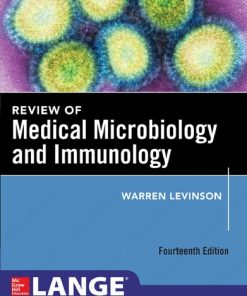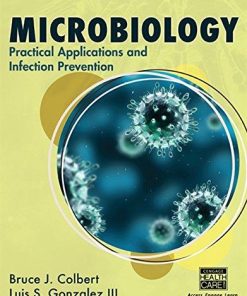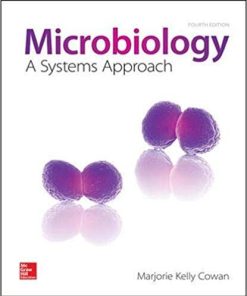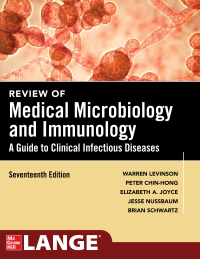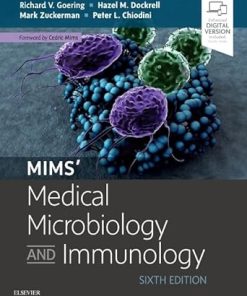(Ebook PDF) Systems Immunology and Infection Microbiology 1st Edition by Bor Sem Chen 0128173351 9780128173350 full chapters
$50.00 Original price was: $50.00.$25.00Current price is: $25.00.
Systems Immunology and Infection Microbiology 1st Edition by Bor-Sem Chen – Ebook PDF Instant Download/DeliveryISBN: 0128173351, 9780128173350
Full dowload Systems Immunology and Infection Microbiology 1st Edition after payment.

Product details:
ISBN-10 : 0128173351
ISBN-13 : 9780128173350
Author: Bor-Sem Chen
Systems Immunology and Infection Microbiology provides a large amount of biological system models, diagrams and flowcharts to illustrate development procedures and help users understand the results of systems immunology and infection microbiology. Chapters discuss systems immunology, systems infection microbiology, systematic inflammation and immune responses in restoration and regeneration process, systems’ innate and adaptive immunity in infection process, systematic genetic and epigenetic pathogenic/defensive mechanism during bacterial infection on human cells is introduced, and the systematic genetic and epigenetic pathogenic/defensive mechanisms during viral infection on human cells.
Systems Immunology and Infection Microbiology 1st Table of contents:
Chapter 1. Introduction to systems immunology and infection microbiology
Abstract
1.1 Introduction
1.2 Content and general outline of the book
Part I: Systems Immunology
Chapter 2. Biological network modeling and system identification in systems immunology and infection microbiology
Abstract
2.1 System identification for gene regulatory network
2.2 System identification of protein–protein interaction network
2.3 System identification of integrated genetic and epigenetic network via high throughput next generation sequencing data
2.4 Conclusion
Chapter 3. Identifying the gene regulatory network of systems inflammation in humans by system dynamic model via microarray data and database mining
Abstract
3.1 Introduction
3.2 Construction of candidate inflammatory gene regulatory network in response to inflammatory stimulus
3.3 Pruning the candidate gene regulatory network via a dynamic gene regulatory model
3.4 On the construction of inflammatory gene regulatory network in immune system
3.5 Biological insight and discussion
3.6 Conclusion
3.7 Material and methods
3.8 Appendix
Chapter 4. Dynamic cross-talk analysis among signaling transduction pathways in the vascular endothelial inflammatory response system of humans
Abstract
4.1 Introduction
4.2 Methods of constructing cross talks among signaling pathways in inflammation
4.3 Signaling transduction, signaling pathways, and their cross talks in inflammatory response
4.4 Discussion
4.5 Conclusion
4.6 Appendix: Supplementary methods
Part II: Systems Infection Microbiology
Chapter 5. Prediction of infection-associated genes via a cellular molecular network approach: A Candida albicans infection case study
Abstract
5.1 Introduction
5.2 Methods of constructing cellular molecular networks in Candida albicans infection
5.3 Infection-associated genes via cellular molecular network approach
5.4 Discussion and conclusion
5.5 Appendix
Chapter 6. Global screening of potential Candida albicans biofilm-related transcription factors by network comparison via big database mining and genome-wide microarray data identification
Abstract
6.1 Introduction
6.2 Systems methods of screening biofilm-related transcription factors
6.3 Potential Candida albicans biofilm-related transcription factors
6.4 Discussion
6.5 Conclusion
6.6 Appendix
Chapter 7. Identification of infection- and defense-related genes through dynamic host–pathogen interaction network
Abstract
7.1 Introduction
7.2 Material and methods of constructing host–pathogen interaction network in Candida albicans–zebrafish infection
7.3 Pathogenic/offensive mechanism between Candida albicans and zebrafish in infection process
7.4 Discussion
7.5 Conclusion
7.6 Appendix
Chapter 8. Host–pathogen protein–protein interaction network for Candida albican pathogenesis and zebrafish redox process through dynamic interspecies interaction model and two-sided genome-wide microarray data
Abstract
8.1 Introduction
8.2 Construction of host/pathogen protein–protein interaction network
8.3 Host/pathogen protein–protein interaction network during the infection process of Candida albicans
8.4 Discussion
8.5 Conclusion
Chapter 9. Essential functional modules for pathogenic and defensive mechanisms via host/pathogen crosstalk network by database mining and two-sided microarray data identification
Abstract
9.1 Introduction
9.2 Material and methods
9.3 Essential functional modules for pathogenic and defensive mechanisms
9.4 Discussion
9.5 Conclusion
9.6 Appendix
Part III: Systematic Inflammation and Immune Response in Restoration and Regeneration Process
Chapter 10. The role of inflammation and immune response in cerebella wound-healing mechanism after traumatic injury in zebrafish
Abstract
10.1 Introduction
10.2 Materials and methods for constructing protein–protein interaction network of cerebellar wound-healing process in zebrafishes
10.3 The role of inflammation and immune response in the cerebellar wound-healing process
10.4 Discussion and conclusion
10.5 Appendix
Chapter 11. Key immune molecular biomarkers in the pathomechanisms of early cardioembolic stroke: Multidatabase mining and systems biology approach
Abstract
11.1 Introduction
11.2 Immune events in pathomechanisms of early cardioembolic stroke
11.3 Material and methods of PPI network construction and principle network projection
11.4 Conclusion
11.5 Appendix
Part IV: Systems Innate and Adaptive Immunity in the Infection Process
Chapter 12. Cross-talk network biomarkers of pathogen–host interaction network from innate to adaptive immunity
Abstract
12.1 Introduction
12.2 Material and methods
12.3 Investigating PH-PPINs for cross-talk network markers from innate to adaptive immunity
12.4 Discussion and conclusion
Chapter 13. The coordination of defensive and offensive molecular mechanisms in the innate and adaptive host–pathogen interaction networks
Abstract
13.1 Introduction
13.2 Materials and methods to coordinate defensive molecular mechanisms in innate and adaptive host–pathogen networks
13.3 Defensive and offensive molecular mechanisms based on the innate and adaptive HP-PPINs
13.4 Discussion
13.5 Appendix
Chapter 14. The significant signaling pathways and their cellular functions in innate and adaptive immune responses during infection process
Abstract
14.1 Introduction of innate and adaptive immune systems
14.2 Materials and methods
14.3 Investigating the defense/offensive strategies of innate and adaptive immunity
14.4 The roles of significant signaling pathways in the innate and adaptive immune responses
14.5 Conclusion
14.6 Appendix
Part V: Systematic Genetic and Epigenetic Pathogenic/ Defensive Mechanism During Bacterial Infection on Human Cells
Chapter 15. Genetic-and-epigenetic host/pathogen networks for cross-talk mechanisms in human macrophages and dendritic cells during Mtb infection
Abstract
15.1 Introduction to tuberculosis infected by Mycobacterium tuberculosis
15.2 Materials and methods for constructing cross-talk GWGEINs and their core networks
15.3 Investigating pathogenic/host defense mechanism to identify drug targets
15.4 Conclusion
Chapter 16. Investigating the host/pathogen cross-talk mechanism during Clostridium difficile infection for drug targets by constructing genetic-and-epigenetic interspecies networks using systems biology method
Abstract
16.1 Introduction
16.2 Materials and methods
16.3 Investigating the cross-talk mechanism by constructing the genetic-and-epigenetic interspecies network
16.4 Discussion and conclusion
Chapter 17. Investigating the common pathogenic mechanism for drug design between different strains of Candida albicans infection in OKF6/TERT-2 cells by comparing their genetic and epigenetic host/pathogen networks: Big data mining and computational systems biology approaches
Abstract
17.1 Introduction
17.2 Materials and methods
17.3 Investigating pathogenic mechanism of C. albicans infection by comparing genetic and epigenetic interspecies networks
17.4 Discussion
17.5 Conclusion
17.6 Appendix
Part VI: Systematic Genetic and Epigenetic Pathogen/Defensive Mechanism and Systems Drug Design in Viral Infection on Human Cells
Chapter 18. Constructing host/pathogen genetic-and-epigenetic networks for investigating molecular mechanisms to identify drug targets in the infection of Epstein–Barr virus via big data mining and genome-wide NGS data identification
Abstract
18.1 Introduction
18.2 Materials and methods
18.3 Investigating interspecies molecular mechanisms for human B lymphocytes infected with Epstein–Barr virus
18.4 HVCNs at the first and second infection stage in the lytic phase of B cells infected with EBV
18.5 HVCPs at the first and second infection stage during the lytic replication cycle
18.6 The transportation process of viral particles through host–virus cross-talk interactions at the second infection stage
18.7 Overview of the lytic infection molecular mechanism from the first to second infection stage in human B cells infected with EBV
18.8 Drug target proteins and multimolecule drug design
18.9 Discussion
18.10 Conclusion
Chapter 19. Human immunodeficiency virus–human interaction networks investigating pathogenic mechanism via for drug discovery: A systems biology approach
Abstract
19.1 Introduction
19.2 Investigate pathogenic mechanisms at different stages of human immunodeficiency virus infection
19.3 HIV/human interaction networks for multiple drug designs at three infection stages
19.4 Methods
19.5 Conclusion
19.6 Abbreviations
19.7 Appendix
Chapter 20. Systems multiple-molecule drug design in infectious diseases: Drug-design specifications approach
Abstract
20.1 Introduction
20.2 Systems drug-design method in infectious diseases
20.3 Discussion
20.4 Conclusion
People also search for Systems Immunology and Infection Microbiology 1st:
immune system microbiology
systems immunology conference
a systemic infection involves the whole body
a systemic infection
immunology infection and initial response
You may also like…
Biology and other natural sciences - Microbiology
Biology and other natural sciences - Microbiology
Mims’ Medical Microbiology and Immunology 6th Edition Richard V. Goering
Medicine - Immunology
Encyclopedia of Infection and Immunity 1st Edition by Nima Rezaei 0323903035 9780323903035
Biology and other natural sciences - Microbiology
Biology and other natural sciences - Microbiology
MIMs’ Medical Microbiology and Immunology 6th Edition Richard Goering
Technique - Electronics




